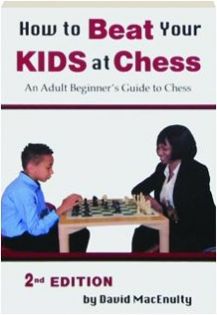How to Beat Your Kids at Chess
An Adult Beginners Guide to Chess
David MacEnulty

Those who did not learn to play chess as a young person have missed years of enjoyment. Those who would like to learn chess as adults may face obstacles such as feeling it may be too late to do so, or if they have limited knowledge, face the embarrassment of always being beaten by their friends.
MacEnultys fine book is for adult beginners who face these obstacles or, are adults who want to help their child learn chess; who are put in charge of a school chess program and need to strengthen their sills rapidly; or are interested in keeping their minds active. This splendid step-by-step book will help adult beginners in these situations and more.
The author, who is an award winning teacher with over two decades experience in teaching children and adults, simply and clearly addresses all these situations in his Introduction. He emphasizes that, the joys of chess are open to all, whatever level we may aspire to or actually reach. Everyone from beginner to World Champion can enjoy this great game.
Adopting an incremental learning approach, MacEnulty moves from the most basic perceptions, explaining the first patterns of chess beginning with straight lines, chessboards, files and ranks, on to the relative value of the pieces and setting up the board. Next chapters include the Chess Pieces, Check, Checkmate, and Stalemate, Chess Notation, and Three Special Moves and the Five Ways to Draw. These chapters are simply written, filled with multiple board diagrams on each page and take us through the basics on which all else in chess is built.
The Introduction to Chess Tactics chapter considers En Prise, Forks, and Pins. These are explained with many graphic examples. The chapter on Forks features a number of Puzzles to enable Forks to be recognized and played out.
In Opening Principles, the principles of Control the Center; Develop the Pieces; and Shelter the King are explored. These are very helpful in giving direction to goals which, when met, can provide a strong position for the middle and end games.
Two More Tactics are the subject of chapter eight: Discovery and Undermining. These two feature puzzles to assist in visualizing the tactics.
The Endgame chapter explores four bacis endings: King and Pawn; Checkmate with a King and Queen against a Lone King; Checkmate with a Rook and King against a Lone Kings; and Rook Endings. These are endings to be mastered to bring a game to a successful conclusion.
The final chapter features Middlegame Lessons from the Great Paul Morphy. The author focuses on three of Morphys historic games to explore the initiative, open lines, compensation, the bad bishop, sacrificing, and other important chess ideas to deepen understanding and enliven ones play. MacEnulty annotates the moves of these games, carefully explaining what is happening throughout the games.
The authors Final Words are and encouraging list of what the reader has learned along the way along with suggestions to play as often as one can, read chess books, and play over master games to learn from the great players of the past. Three Appendices are added: Quick Guide to the Openings; The Moves and Rules of Chess; and Extra Checkmate Practice.
This book can be highly recommended as a fine chess-learning tool by an author who has received a Lifetime Achievement Award from the U.S. Chess Federation and a Lives that Make a Difference award from A&E Television. The book will be a great gift for anyone desiring to delve into chess and also a most helpful reminder of many basic points for those who want to get a better grounding in the game or brush up on key elements in chess. It is highly recommended! MacEnultys final benediction is a good one for all: May the passion, beauty, logic, and thrill of the great game of chess be with you always. Amen!
